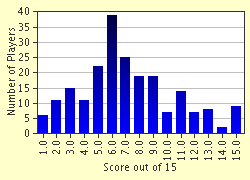Quiz Answer Key and Fun Facts
1. Having disengaged from their war with the Poles at the truce of Altmark, in what year did the Swedes enter the Thirty Years' War?
2. Which of the Electors of the Holy Roman Empire was the first to ally with the Swedes upon their invasion of North Germany?
3. Who was the redoubtable general in charge of the Imperial Army facing the Swedes at the First Battle of Breitenfeld (1631)?
4. It has already been noted that the Swedes were fighting the Imperialists; this is the shorthand name used to describe men fighting for the Holy Roman Emperor; who was emperor at the time of the battle of Breitenfeld in 1631?
5. At which battle did the Swedish king Gustavus Adolphus die?
6. In 1632 Gustavus Adolphus' army is said to have been 210,000 men strong?
7. Upon Gustavus Adolphus' death which man took up the challenge of running the Swedish state and war effort?
8. At the battle of Nördlingen (1634) the Swedish armies were commanded jointly; one of the commanders was a German called Bernard. Of what duchy was he duke?
9. The Swedish war effort picked up again after 1636, with the entry into the war proper by France, a country rapidly on the way to superseding Spain as the greatest of Catholic nations. Which famous man was the power behind the French throne till his death in December 1642?
10. Upon the death of Gustavus Adolphus his only child was a minor; hence government being taken over by Axel Oxenstierna. In what year did the new monarch reach the age of majority?
11. Which Scottish colonel, wrote the first regimental history in the English language concerned with his time fighting for the Swedes in Germany?
12. While Sweden was warring in Germany her old enemy, Denmark, had been making trouble in the Baltic. Upon learning in 1643 that the Danes were negotiating an alliance with the Emperor, the Swedes decided to strike first and invaded Denmark. Which general did the Emperor send to aid the Danes?
13. The Thirty Years' War was famously ended in 1648 with the Peace of Westphalia. This peace was in fact made of two treaties, which did the Swedes sign?
14. Sweden, it can be argued, did very well out of the Thirty Years' War and could feel that her goals had been attained. What area of Germany did she NOT receive?
15. At the end of The Thirty Years' War in 1648, Sweden still had thousands of troops in her pay. In what year was the last of her soldiers withdrawn from non-Swedish land in Germany?
Source: Author
wyrmirae
This quiz was reviewed by FunTrivia editor
bloomsby before going online.
Any errors found in FunTrivia content are routinely corrected through our feedback system.

